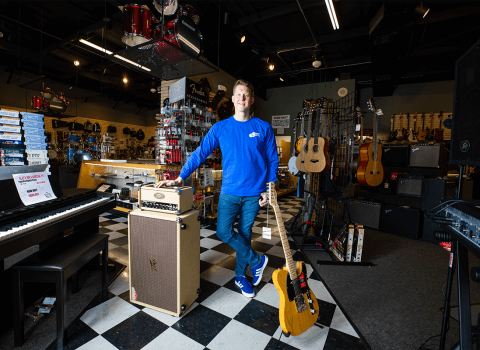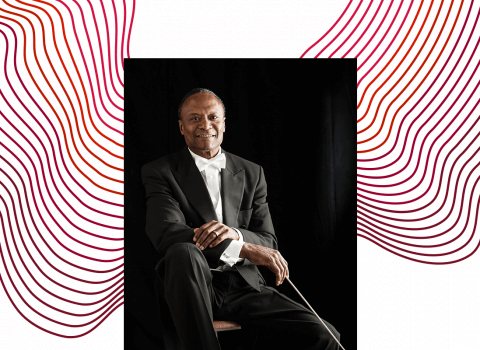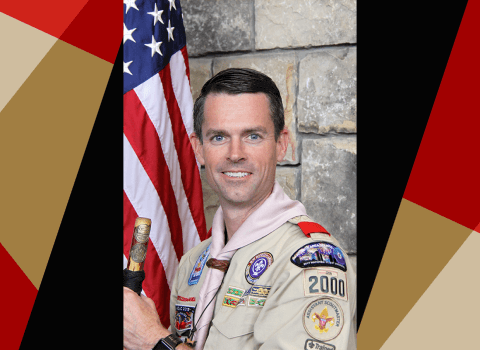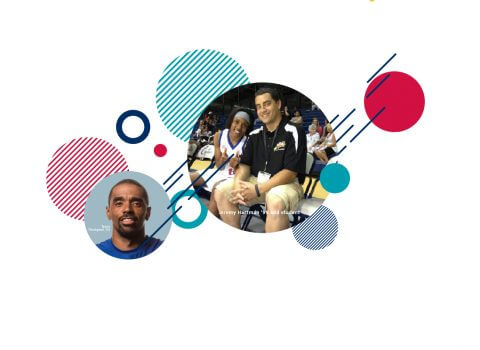Greg Anderson and Elizabeth Joy Roe, better known as Anderson & Roe Piano Duo, are almost considered rock stars in the classical music world. The pair offered up an electrifying performance in Armstrong Concert Hall in April, and the following day, they spoke to students at Shenandoah Conservatory’s Ruebush Hall about how they’ve built their brand as artists.
The pair regularly uses low-tech options to create buzz. They post on Facebook, Instagram, and Twitter. They make YouTube videos (Anderson is frequently the video editor and they often co-direct.) Their website is interactive and fun, and even includes recipes for cocktails that pair well with the pieces they play.
Anderson and Roe, both Juilliard School graduates, said that at heart, the most important way to build a following (or brand) is through being willing to push boundaries and engage, delight and connect with people. When they spoke to Shenandoah students, they clearly noted that students don’t have to do exactly what they did, nor should they.
“We’re trying to open your minds to what’s possible,” Anderson said. Their success has stemmed from what is innate and authentic to them as performers, and from the music itself. “We want our music to be relevant. We want the music to feel immersive and involving,” Roe added. Their mission, as stated on their website, is “to make classical music a relevant and powerful force in society.”
Their website helps in this mission by being entertaining, drawing people toward purchasing their compact discs and scores and attending their concerts. They sometimes recognize members of their online community at concerts, Roe said. They also use social media to keep fans engaged, because if people are passionate and connected, they’ll be excited at a concert, too, Anderson noted. “The music wouldn’t exist if there weren’t listeners there in the first place.” The pair highly value bringing fans into the concert experience, which is communal, present and in the moment. They note that they want it to be almost like a Pixar movie: perfect for all ages and for everyone from aficionados to novices.
Their videos play a large role in generating excitement. The videos must stand out, by being eye-catching and entertaining, the pair said. They must provide more than a microphone and camera at a live performance. The duo have taken some inspiration from the visual imagination of the pop world, as well as the low-budget DIY ethos often valued online, as they work to find ways to visually highlight emotions already inherent in the music. “We take a hands-on approach,” Roe said.
For their “Rite of Spring” video they acquired an old organ and then, “We literally put an organ in the ocean,” Roe said.
They can use Google as a resource for technical needs, like color settings and visual effects.“It’s pretty amazing what anyone can do,” Anderson said. Both noted that with a strong vision, “infinite possibility” exists in terms of presenting that vision.
For example, for their performance of “Dance of the Blessed Spirits,” they used $40 of silks and slowed-down video to great effect.
While for their cover of Daft Punk’s “Lose Yourself to Dance,” they put two Steinway grand pianos in a roller rink and let the lights and retro decor do most of the visual work.
They’re Steinway artists. So, in another instance, they partnered with the piano maker for mutual benefit, using Steinway’s digital player piano, the Spirio, while also gaining exposure for themselves as well, via a performance of “Mambo” from the musical “West Side Story.”
https://www.youtube.com/watch?v=z8v-TIX87P0
Their approach also connects to another of their passions, which is community outreach that brings artists out of concert halls and into classrooms, and truly ends up being about engagement with, and accessibility to, the music.
Anderson & Roe’s viewpoint made music education major and saxophone player, Drake Stoughton ’18, consider expanding his social presence and think about how to present performance with creative visuals. He said he was most impressed by seeing how the pair created their own avenue toward success and appreciated their focus on outreach. “I was definitely able to connect with that.” Additionally, it made him think more about how he would promote himself as a performer – as a music education student, he has not focused on marketing himself as an artist, unlike his classmates pursuing performance degrees at the conservatory.
Branding is truly about stimulating consumers’ minds, said Business School Assistant Dean of Student Affairs Fritz Polite, Ph.D., who also attended the Anderson & Roe presentation. Their talk touched on areas like marketing, social media impact and personal branding – all of which are of interest to business school students. In their comments he could also see potential for Shenandoah’s students, noting that a combining the strengths of the conservatory and the business school would provide a fertile environment for symbiotic growth.
Featured photo credit: Lisa-Marie Mazzucco






